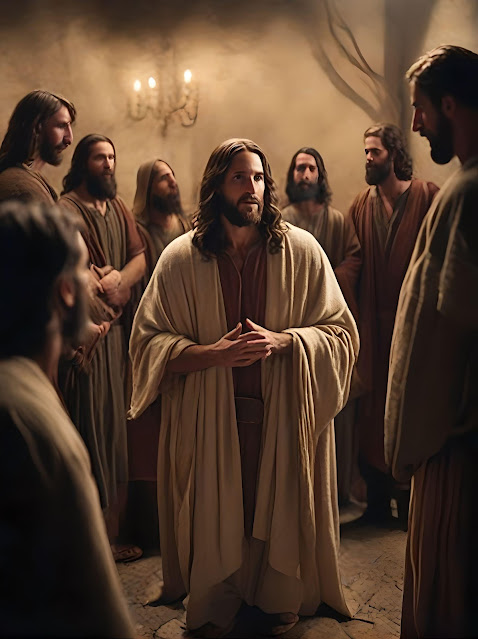Overview of 1 Nephi 6-10
The scriptures in 1 Nephi 6-10 offer a rich tapestry of spiritual insights and teachings, with the Tree of Life standing as a profound and central symbol. These chapters present Lehi's powerful vision, which provides a blueprint for understanding the journey of God's children. The vision of the Tree of Life and its accompanying elements hold deep spiritual significance, guiding individuals on their path towards God's love and blessings.
Among the teachings found in these chapters, the Tree of Life is a prominent and profound symbol that encapsulates the central message of the gospel. Understanding the context and symbolism of 1 Nephi 6-10 is vital for individuals seeking spiritual enlightenment and growth. It provides a foundation for comprehending the broader message and teachings found within these chapters, offering profound insights into the nature of God's love, the power of faith, and the significance of making and keeping sacred covenants.
Furthermore, the narrative within 1 Nephi 6-10 incorporates essential themes such as Covenant Marriage, Power of Forgiveness, Power of Faith, and Power of Testimony. These concepts are not only integral to the storyline but also hold significant relevance in the lives of individuals seeking spiritual growth and a deeper understanding of the gospel. For instance, the symbolism of the Tree of Life and the obstacles encountered in Lehi's vision offer profound lessons about the trials and triumphs of mortal life, highlighting the importance of faith, forgiveness, and the power of testimony in navigating life's challenges.
Understanding the significance and context of 1 Nephi 6-10, particularly in relation to the Tree of Life, is essential for individuals seeking a deeper spiritual understanding and a closer relationship with God. It serves as a guiding light, illuminating the path towards divine love and emphasizing the fundamental principles of faith, forgiveness, and the power of testimony in the context of spiritual growth and personal development.
Understanding Lehi's Vision
Lehi's vision in 1 Nephi 6-10 offers a wealth of symbolism that provides deep insights into spiritual truths. One of the central symbols is the tree of life, which represents the love of God, and its fruit symbolizes the blessings made possible through Jesus Christ. This powerful imagery underscores the central role of Christ's Atonement in bestowing divine blessings upon all of God's children. Understanding this symbolism can profoundly impact one's perspective on the purpose of life and the significance of the Savior's mission.
In addition to the tree and its fruit, Lehi's vision presents various obstacles, such as the mists of darkness, the iron rod, and the great and spacious building, each carrying profound symbolic significance. For instance, the mists of darkness can represent the worldly distractions and temptations that hinder individuals from finding and partaking of the love and blessings of God. On the other hand, the iron rod, symbolizing the word of God, serves as a guiding source of strength and safety during times of trial and temptation. It emphasizes the importance of clinging to the word of God as a source of guidance and protection throughout life's journey.
Furthermore, the great and spacious building serves as a symbol of pride and worldly influence, contrasting with the humble and steadfast path represented by the iron rod and the tree of life. Understanding these symbols can provide profound insights into the spiritual obstacles and challenges that individuals encounter in their quest for eternal truth and happiness.
Moreover, the vision of the Tree of Life teaches us how to stay on the path to enjoy God's love. The painting of Lehi's vision includes the tree representing God's love and its fruit symbolizing blessings through Jesus Christ. In the vision, there are obstacles such as the mists of darkness, the iron rod, and the great and spacious building. The iron rod represents the word of God and holding fast to it will provide safety and strength during temptations. It is important to evaluate our scripture study goals and strive to come unto Christ despite distractions and temptations.

The Role of Nephi
Nephi's quest for truth and personal revelation is a pivotal aspect of his character and is exemplified in 1 Nephi 7:6–21, emphasizing the significance of seeking individual spiritual confirmation. In this passage, Nephi's unwavering determination to seek truth serves as a poignant example of the importance of personal spiritual experiences and the role they play in strengthening one's faith. His actions highlight the principle that each individual has the opportunity to seek and receive personal revelation, which can lead to a deeper understanding of divine truths and principles.
Furthermore, the narrative underscores the transformative power of forgiveness, as demonstrated by Nephi's ability to forgive others despite their transgressions. Nephi's willingness to extend forgiveness and let go of resentment not only showcases his capacity for compassion and empathy but also serves as a powerful reminder of the liberating nature of forgiveness. This act of forgiveness not only fosters inner peace and emotional healing but also exemplifies the teachings of Christ regarding the necessity of forgiving others, thus illuminating the redemptive nature of forgiveness in the context of spiritual growth and personal development.
The differing reactions to prophetic teachings portrayed by Nephi and his brothers serve as a poignant illustration of how individual responses to divine counsel can shape lives. Through the contrasting reactions of Nephi and his brothers, the narrative underscores the profound impact that personal choices and responses to spiritual guidance can have on one's spiritual journey. This serves as a reminder of the agency granted to individuals and the transformative influence that embracing or rejecting divine teachings can have on their lives, thus emphasizing the profound significance of personal agency and the power of individual decisions in the context of spiritual progression and personal apostasy.
Additionally, Nephi wanted to learn the truth of his father's words for himself. Prophets may extend invitations for youth to act in faith. Different reactions to prophetic teachings can influence lives. Nephi and his brothers had different reactions to their father's words. God reveals truth to us through the Holy Ghost when we diligently seek Him. Nephi learned that Heavenly Father blesses us with the Holy Ghost as we seek truth from Him. Personal revelation matters and can lead to life-changing experiences. Record what you have learned from this lesson in at least three sentences in your study journal.

The Book of Mormon's Relevance
Nephi's purpose in recording the Book of Mormon goes beyond just documenting historical events. It is evident that his intention was to persuade individuals to come unto Jesus Christ and to contain only things that are pleasing to God. This demonstrates that the Book of Mormon is not merely a historical record, but a spiritual guide that directs individuals towards Christ and righteousness.
Studying the Book of Mormon can be a blessing in our lives by helping us come closer to Jesus Christ and know the things that are pleasing to God. It provides a roadmap for personal and spiritual growth, offering insights and wisdom that can guide individuals through life's challenges. As individuals engage with the teachings and principles within the Book of Mormon, they are presented with opportunities to deepen their understanding of God's will and purpose for their lives, thereby experiencing spiritual enrichment and enlightenment.
Reflecting on how studying the Book of Mormon can be a blessing in our lives by helping us come closer to Jesus Christ and know the things that are pleasing to God is an essential aspect of personal and spiritual development. It encourages introspection and self-examination, fostering a deeper connection with divine principles and truths. This depth of understanding and spiritual insight can equip individuals with the resilience and faith needed to overcome trials and tribulations, ultimately leading to a more profound relationship with Jesus Christ.
Nephi recorded the Book of Mormon with the intent to persuade people to come to Jesus Christ and to contain only things that are pleasing to God. Reading the Book of Mormon can help us know the things that are pleasing to God and come closer to Jesus Christ. Studying the Book of Mormon can be a blessing in our lives by helping us come closer to Jesus Christ and know the things that are pleasing to God. Nephi's purposes in recording the Book of Mormon can be found throughout the text and can help us come unto Christ and know what pleases God. The events in 1 Nephi 7 can be divided into three parts, each with elements that please God and help us come unto Christ. Reflect on what you learned from your scripture study and how it can help you come unto Christ and please God. Consistently approaching scripture study with the intent to find things that help us come unto Christ and please God can improve our study experience.

Symbolism in Lehi's Vision
Lehi's vision is rich with symbolism, inviting individuals to reflect on their own spiritual journey amidst life's challenges and distractions. The obstacles in the vision, such as the mists of darkness, the iron rod, and the great and spacious building, serve as powerful metaphors for the trials and influences encountered in mortality. The mists of darkness represent the temptations and uncertainties that can shroud one's path, while the iron rod, symbolizing the word of God, provides safety and strength during these adversities. This imagery encourages individuals to hold fast to their faith and the teachings of the gospel, even in the face of adversity, and find their way to the tree representing God's love and the blessings of Jesus Christ's Atonement.
Lehi's vision also serves as a reminder of the role of personal revelation and the influence of the Holy Ghost in the lives of believers. It underscores the importance of diligently seeking divine truth and the blessings that come from experiencing the love of God through the Atonement of Jesus Christ. The symbolism within the vision invites individuals to ponder their personal experiences with the Savior's blessings and recognize the transformative power of God's love in their lives. By understanding the symbolism of the Tree of Life and its various elements, individuals can deepen their spiritual understanding and fortify their commitment to the path of discipleship, guided by the word of God and the love of the Savior.
Evaluating scripture study goals and striving to come unto Christ despite distractions and temptations is an important aspect of understanding the symbolism in Lehi's vision. Recognizing how the fruit on the tree represents the blessings of the Savior's Atonement and pondering ways in which individuals have experienced the blessings Jesus Christ offers or have seen this in other people’s lives can reinforce the spiritual significance of the vision. Additionally, understanding and recognizing how God reveals truth through the Holy Ghost as individuals diligently seek Him can deepen one's appreciation for personal revelation and the role of divine guidance in their lives. These reflections can lead to a more profound understanding of the spiritual symbolism found within Lehi's vision, fostering a deeper connection with the principles and truths it represents.
The Tree of Life and Christ's Atonement
The symbolism of the Tree of Life in 1 Nephi 6-10 is a powerful metaphor that encapsulates the profound significance of the Savior's Atonement. The tree represents not only God's love but also the blessings and redemption offered through Jesus Christ. Just as the fruit of the tree brings joy and fulfillment, the Atonement of Jesus Christ offers spiritual nourishment and healing to all who partake of it. This is a reminder for individuals to reflect on their personal experiences and encounters with the Savior's love and grace. It prompts them to ponder the ways in which they have felt the profound influence of God's love through the Atonement of Jesus Christ.
Understanding the Tree of Life as a representation of the Savior's Atonement allows individuals to recognize the profound impact of God's love on their lives. It encourages them to seek moments where they have felt the transformative power of the Atonement, both in their own lives and in the lives of others. By recognizing these instances, individuals can deepen their spiritual understanding and develop a more intimate and profound connection with divinity. It prompts them to consider how the blessings of the Atonement have manifested in their lives, fostering a greater sense of gratitude and reverence for the love of God as exemplified through Jesus Christ.
The Savior helps us feel the love of God. The fruit on the tree represents the blessings of the Savior's Atonement. God's love, manifest through Jesus Christ, brings the most joy. Recognize how you might feel God’s love for you because of Jesus Christ. Ponder ways you have experienced the blessings Jesus Christ offers or how you have seen this in other people’s lives.
Nephi's Blueprint
Nephi's vision in 1 Nephi 6-10 serves as a meticulously constructed blueprint that underscores the centrality of Christ's identity, mission, and teachings. It offers a comprehensive guide for understanding the principal themes of his writings in the Small Plates. Through his vision, Nephi provides valuable insights into the importance of aligning our lives with the teachings of Jesus Christ and embracing His mission for our spiritual growth and understanding.
When we approach scripture study with the intent of discovering insights that facilitate drawing closer to Christ and pleasing God, it not only enriches our spiritual understanding but also enhances the overall study experience. Nephi's blueprint invites us to delve deeper into the scriptures, seeking to understand how the teachings and experiences shared can guide us in our personal journey towards Christ. Each passage becomes an opportunity to uncover profound truths and embrace the timeless wisdom encapsulated in the Book of Mormon.
Interpreting Nephi's vision as a guide for understanding the principal themes of his writings in the Small Plates is essential for individuals seeking a deeper spiritual understanding and a closer relationship with Jesus Christ. By recognizing the interconnectedness of the themes present in his vision, individuals can gain a more comprehensive understanding of the broader message and teachings found within the Book of Mormon. This approach can lead to a more profound and enriching study experience, fostering a deeper connection with the timeless truths and principles found within the scriptures.
Apocalyptic Revelations
The apocalyptic nature of Lehi's dream, Nephi's vision, and the subsequent prophetic writings in 1 and 2 Nephi are profoundly relevant to the understanding of the last days. These visions provide valuable knowledge and assurances, offering a message of hope in the face of apocalyptic events. The apocalyptic quality of these revelations is characterized by their deep interconnectedness, with each revelation building upon the themes and symbols of the previous ones. They are designed to guide and comfort the covenant people of the Lord on earth as they face the challenges of the last days, offering a beacon of hope amidst the tumultuous events that will unfold.
Nephi's experience of receiving his vision illustrates the reality of God's promise to reveal profound truths. This is akin to the visions seen by other notable figures in religious history, such as John the Beloved and the brother of Jared. The depth and breadth of the visions granted to Nephi serve as a testament to the divine guidance and insight provided to individuals who seek to understand the unfolding of God's purposes in the world. It underscores the divine nature of the revelations contained in the Book of Mormon, which are intended not only to enlighten but also to fortify and comfort those who earnestly seek to comprehend the divine plan for humanity in the last days.
Recognizing the apocalyptic nature of Lehi's dream, Nephi's vision, and the later prophetic writings in 1 and 2 Nephi is essential for individuals seeking a deeper understanding of the divine plan for the last days. By understanding the interconnectedness of these revelations and their message of hope amidst tumultuous events, individuals can find comfort and reassurance in the knowledge that God's promises are sure and that His guidance is ever-present. This understanding can lead to a deeper appreciation for the timeless truths and principles found within the Book of Mormon, offering a source of spiritual strength and guidance in the midst of uncertainty and turmoil.
Understanding the Rod of Iron
The symbolism of the rod of iron in Lehi's vision is deeply significant, as it represents the word of God leading individuals to the fountain of living waters or the tree of life. This powerful visual metaphor illustrates the active invitation to follow Christ and highlights the importance of remaining faithful to divine guidance as we navigate life's challenges. Just as the rod of iron provided safety and strength during temptations in Lehi's vision, it serves as a reminder that our faithfulness to the word of God can lead us to spiritual nourishment and communion with the Savior.
Additionally, the rod of iron finds its roots in ancient Near Eastern cultures, where it symbolized the right to rule and was held by gods, kings, and shepherds. Understanding the historical context of this symbol enriches our appreciation of its spiritual significance and reinforces the importance of following the Shepherd-King, Christ, to the fountain of living water and the tree of life. This symbolism invites us to view the Lord as our Shepherd, guiding and protecting us as we hold fast to His word and walk in faith.
Recognizing the rod of iron as an invitation to follow Christ and trust in His grace can deepen one's understanding of the symbolism found within Lehi's vision. By embracing the profound significance of this symbol, individuals can strengthen their commitment to the path of discipleship and find spiritual safety and nourishment in the word of God. This understanding can lead to a more profound and enriching spiritual experience, fostering a deeper connection with the teachings and principles found within the scriptures.
Conclusion
Exploring the teachings and symbolism present in 1 Nephi 6-10 reveals profound spiritual insights and guidance for personal growth and understanding of the gospel. The context and significance of Lehi's vision, along with the themes of forgiveness, faith, and testimony, provide a valuable framework for navigating life's challenges and strengthening one's relationship with God and Jesus Christ.
Understanding the context of Lehi's vision, including the obstacles such as the mists of darkness, the iron rod, and the great and spacious building, allows individuals to draw parallels to their own lives. For example, the symbolism of the iron rod representing the word of God and providing safety and strength during temptations can guide individuals in finding spiritual safety and strength amidst trials. By reflecting on the significance of the tree representing God's love and its fruit symbolizing blessings through Jesus Christ, individuals can recognize the abundant blessings available through the Savior's Atonement.
Moreover, the themes of forgiveness, faith, and testimony underscore the importance of personal spiritual growth and development. Learning from Nephi's example in frankly forgiving others and recognizing the power of personal revelation and the Holy Ghost can inspire individuals to embrace forgiveness and seek divine guidance in their own lives. These themes also emphasize the relevance of the concepts discussed in the context of strengthening one's faith, deepening personal testimony, and understanding the gospel more fully, ultimately leading to a closer relationship with the Savior.


.jpg)













